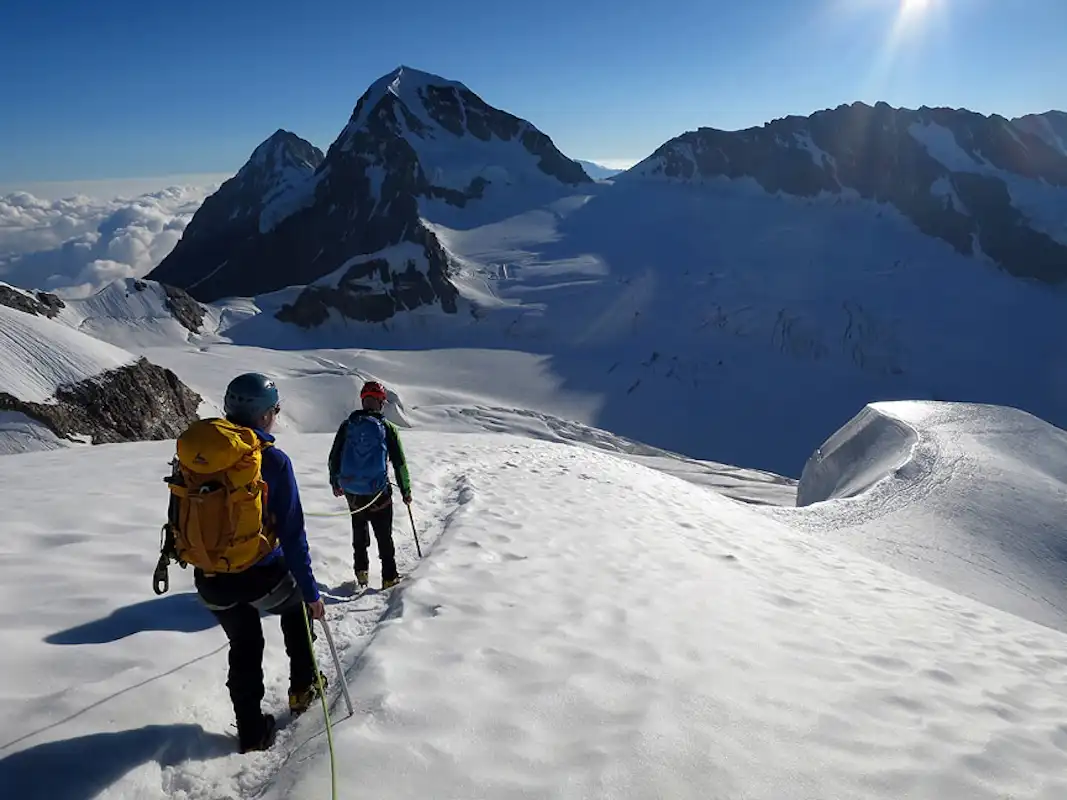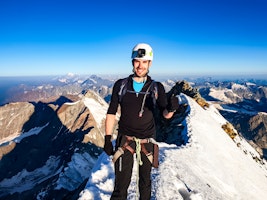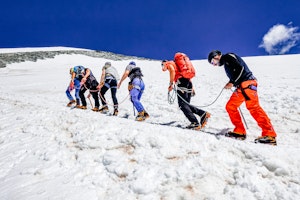As one of the most evocative peaks in the Swiss Alps, Jungfrau (4,158m) has become an exciting objective for mountain climbers and tourists alike. Located in the Bernese Alps and boasting an impressive North Face that rises about 3,000 meters from the valley below, it is the westernmost and highest of the impressive 10-kilometer trio of Bernese peaks that include the Eiger and Monch.
First climbed in 1811 by two Swiss brothers and their accompanying party, it was the focal point of mountaineers for the better part of a century. It was ascended by a number of ambitious climbers who enjoyed its long approach over the glaciers on the southern side of the mountain. The Aletsch Glacier, which is the largest in the entire Alps, reaches to Jungfrau on its western arm known as the Aletschfirn.
At the beginning of the 20th century, the saddle between Jungfrau and Monch, known as the Jungfraujoch, received the highest railway station in Europe and rests just below the summit at 3,454 meters. This added allure to the Jungfrau ascent for climbers who wanted to conquer a classic in the Swiss Alps by making the summit that much easier to reach.
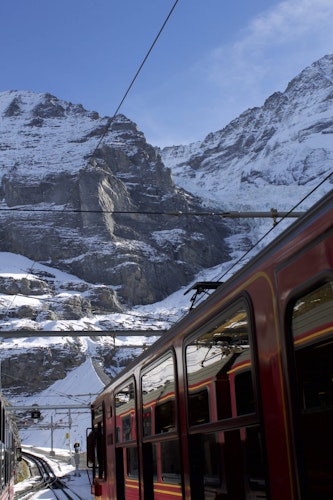
Today the Jungfrau is a challenging yet inviting summit for intrepid mountaineers. It towers over and defines the beautiful towns of Interlaken, Grindelwald, and Lauterbrunnen. The classic and storied ascent has developed over time, thanks to the easy access provided by the Jungfraujoch railway station. Now this climb can even offer an ice palace and chocolate shop to include in your trip. Make a visit to the Sphinx Observatory before or after your climb to take in the view of the mountain you just conquered – or are about to conquer.
The climb is visually unforgettable. The stark contrast of the valley and its quaint villages below the North Wall is impressive, to say the least, and has greatly contributed to the overall appeal of the mountains to daring mountaineers. The elegant peaks of Monch, Eiger, and the surrounding Alps are all visible from summit panoramas, placing you further under the influence of the region’s historic spell.
Ready to take on the challenging and fulfilling ascents on one of the most intimidating peaks in the Bernese Alps? Check out these great mountain climbing trips on Jungfrau NOW!
Starting Point and How to Get There
Getting to the top of Jungfrau is a scenic delight, including some of the most beautiful areas of Switzerland and the Alps. With a variety of options to reach infamous destinations, the journey to the peak is almost as exhilarating as the climb itself.
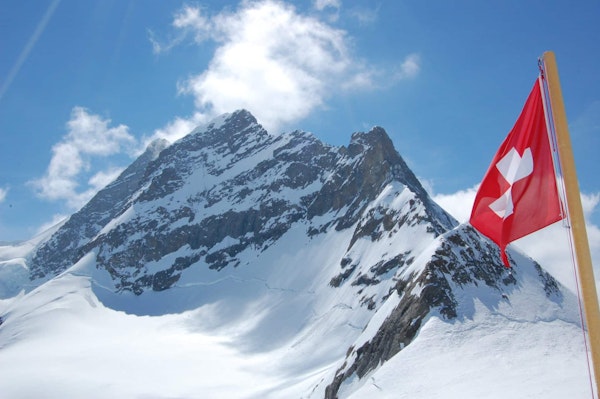
From the Bern Airport to Interlaken, it is roughly 50 kilometers, with a slightly longer distance covered by train in just over an hour. From there, head to Grindelwald or Lauterbrunnen (in around 45 minutes or 20 minutes by train, respectively). If you are taking the cog railway to the col, trains from both locations will take you to Kleine-Scheidegg for this route.
Taking the Kleine-Scheidegg to the Jungfraujoch provides access to all of the features below the summit of Jungfrau, such as the ice palace and the Sphinx Hall. This “Top of Europe” ride is an added bonus to climbing trips on this indomitable peak. Almost all of the climbing trips following the Normal Route, as well as other ascents, will include a stop at Monchsjoch Hut, which is also located at Jungfraujoch.
Duration of the Ascent
The ascent is relatively straightforward. From Jungfraujoch, the saddle between Monch and Jungfrau, it takes four hours to cover the nearly 850-meter ascent. Depending on the weather and the season, this can be a bit more demanding and take an additional hour or two to complete.
Most climbs include a night at the Monchsjoch Hut at 3,658 meters. This allows for a train ride to Jungfraujoch on one day, and an early start to the summit on the following morning. For trips to the summit, it is safe to plan at least two days for a safe and successful attempt. Here are a few guided programs:
Two-day guided ascent with IFMGA-certified guide Roger.
Two-day ascent of Jungfrau in the Swiss Alps with certified guide Tim.
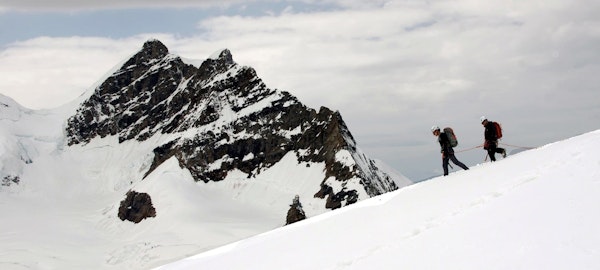
Other ascents that do not include a train trip up to the col increase the approach time. Grindelwald to Monchsjoch is a five to seven-hour climb, which can lead to a three-day program with additional time allotted for two nights in the high mountain hut and the extended descent.
Check out this three-day ascent from Grindelwald with IFMGA-certified guide Marija!
Other programs combine Jungfrau with other peaks, most notably Eiger and Monch. Because of their proximity, these climbs can be completed in two days, though often include more time to enjoy the experience on all of the summits. Here are a few examples:
Jungfrau, Eiger, and Monch four-day climbing trip.
Jungfrau and Monch two-day guided climb.
Three-day Oberland glacier tour.
Climbing Routes
There are a few different routes up to the summit with varying levels of difficulty. The time of year will also play a role in which route mountaineers should take.
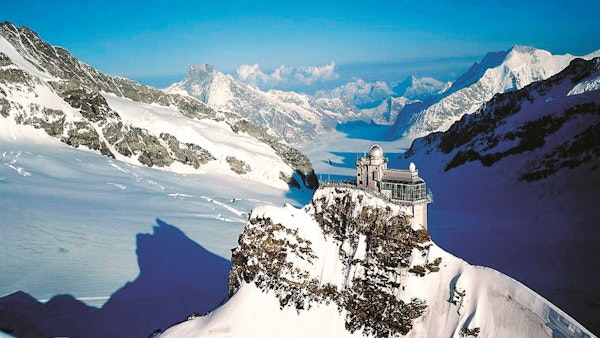
Normal Route
This is the easiest and most common route, starting from the Monchsjoch Hut and climbing just under 1,000 meters to the summit of Jungfrau. It takes four hours on average, usually covering two days for ideal conditions.
The route begins with a glacier traverse of the Aletschfirn before coming upon mixed snow and rock climbing. After completing the steep approach to Rottalsattel, you will traverse snow and ice up to an airy ridge before hitting the top.
The ascent can reach forty to fifty degrees, so its modest climbing grade (II to III) can be misleading. Most of the available climbs take place on this route, reserving the others for more advanced mountaineers.
Inner Rottal Ridge
This southwest route is a bit longer, requiring six to eight hours to complete. It follows the southern section of the southwest ridge for a sustained Grade III climb. From the Rottal Hut, which is easily accessed from Stechelberg on the Lauterbrunnen part of the wall, climbers ascend a steep L-shaped route into easy crags.
After a fixed rope climb on a slanted couloir, you will reach merging ridges and a section of simple maneuvering up to nearly 3,800 meters. A steep mixed climbing section ensues, though it can be avoided if need be. Follow this up around to the summit for the same incredible views.
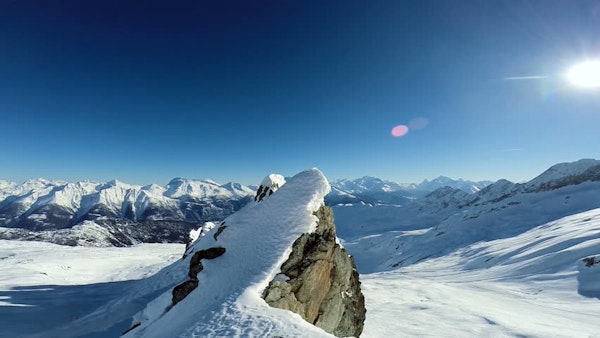
Guggi Route
The declining condition of the glaciers has caused this route to fall out of fashion, but it can still provide a lot of excitement and adventure for those willing to participate. Beginning from the Guggi Hut just down the mountain from Jungfraujoch, you will make your way across crevasses and rocks with the help of iron cables. The icefalls and glaciers are the most problematic aspect of the climb, so be careful on this next portion.
Climb directly up the Schneehorn to the snowy ledge, or head across the Giessen Glacier and make for the Silberhorn at 3,543 meters. This location is due west of the summit, so head for the ridge and steep snow slope. This will take you to mixed snow and ice to the top. If you love glaciers, this is the perfect ascent for you.
Northeast Ridge
For advanced climbers, this is a great option that has some Grade III and IV segments from the Monchsjoch Hut. Approaching from under the south side of the ridge, you will climb the couloir and follow it around to the North Face.
A crest of snow leads to a steep wall, thus putting advanced climbers to the test with a few rocky pinnacles. Leveling out at the Hochfirn for one last glacier traverse, the final summit push is a steep section of snow. A formidable challenge that is more than worth the reward.
Physical Requirements and Technical Difficulties
This is a great climb because of its wide variety of disciplines. It is a mixed snow climb that covers glaciers and traverses, and includes an airy ridge for the cherry on top of the summit. Add in a modifiable approach, and you can cover every single one of your mountain climbing bases.

Mountaineers should be in good shape to take on the crags of Jungfrau. The Normal Route is a relatively short climb, but it does boast a variety of challenging obstacles. Mountaineers can expect to come across a number of glaciers and plenty of mixed climbing. The technical climbing isn’t particularly difficult, but it certainly does require some skill and focus.
A steep ridge of snow and ice is waiting towards the top of the climb, making it a formidable ascent. The ridge is more exposed than difficult, so it requires patience and attention. Adverse weather can take a serious toll on climbing conditions.
Weather Conditions
The best season to climb this peak is from June to September. Temperatures are very cold on Jungfrau, even in the summer. It receives quite a bit of sunshine throughout the climbing season, averaging over six hours of sunshine from June through September. The high altitude does lend itself to volatile weather, and storm systems have been known to come in quickly and powerfully.
The top of the mountain is glaciated and has year-round snow. Snow falls regularly in June, July, and August, so fresh powder is common. For anyone looking to parlay their mountaineering experience into a more ambitious climbing and skiing combination.
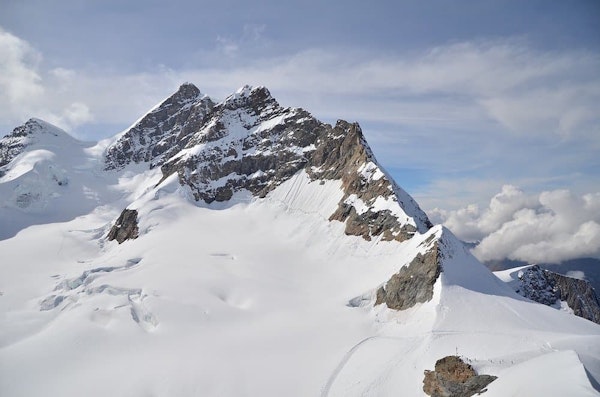
Equipment
The mixed climbing required to summit Jungfrau means a complete mountaineering kit. You should come to the Bernese Alps prepared for a serious climb. Your equipment should include, but is certainly not limited to:
Helmet
Harness
Ropes
Belay device
Ice axe
Crampons
Ice screws
Avalanche safety gear
Carabiners
Camping equipment
Cold weather clothing and protection
Sun protection
Durable mountaineering boots
Water bottle
Because of the cold weather, warm gloves and hats should also be included in your pack. A 30- to 40-liter backpack is essential, as is a first aid kit. If possible, consult your guide as they will have the best idea of any additional items you may want or need for your specific program.
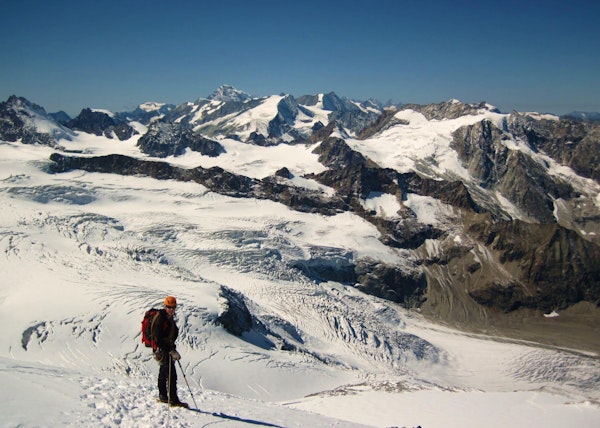
Stop dreaming and start climbing! Sign up today for one of the incredible Jungfrau ascents and discover the relentless beauty of the Bernese Alps! Don't miss out on one of Switzerland's most indomitable peaks!
